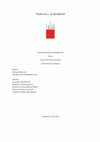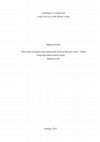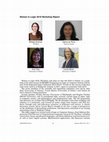Thesis Chapters by Mihaela Rozman

Interventions for prevention of occupational psychosocial damage – Study of psychosocial risk evaluation
This is a summary of a master thesis and its six chapters, 151 pages and 213 pieces of literature... more This is a summary of a master thesis and its six chapters, 151 pages and 213 pieces of literature. This article examines the regulatory framework for managing psychosocial risks in the European Union, focusing on the implementation challenges of the Participatory Intervention from an Organizational Perspective (PIOP) model. Through a case study of a higher education institution in Austria, the study highlights the complexities of aligning organizational practices with European directives, such as the EU Framework Directive 89/391/EEC on Safety and Health at Work. The findings emphasize the importance of regulatory compliance and active stakeholder participation in overcoming the challenges inherent in psychosocial risk management. It is argued an analysis such as this can be used as a proxy to design and implement any kind of change in organisations, thus be a tool for managing change.

The following essay deals with the topic of high-involvement work systems (HIWS) and their effect... more The following essay deals with the topic of high-involvement work systems (HIWS) and their effect on the intra-organisational socio-political system. I am focusing on the contexts in which “high-involvement work systems” (HIWS) are most likely to be cost-effective. As the practice reveals, even though in general HIWS are linked to increased performance of an organisation (Tomer 2001; Koski and Järvensivu 2010), the positive results may strongly differ in their scope, on the one hand contesting the possibility of generalization of the HIWS principles (Wharton 1999; Konrad 2006) and on the other represent a challenge for which most firms are not prepared to face (Guthrie 2001; Koski and Järvensivu 2010).
Therefore in the first part of the essay we analyse the structure of HIWS, the main argumentation pro and contra based on its performance following in the second part of the essay where we analyse the social architecture of the work place on the basis of secondary literature. Secondly, in the third part of the essay we are able to put forwards possible socio-political issues, raised from the micro environment of the firm in the process of HIWS implementation. With secondary literature analysis we try to construct the meanings of the organisational environment for the actors of HIWS implementation, dealing with obstacles when implementing the HIWS. In the conclusion we try to answer the question of what kind of contexts are most likely to adapt well to the HIWS and what can the senior management do, when their strategy of HIWS is contested.
The findings of the paper see the need for institutional arrangement which would collect and propose the criteria and independent evaluation practices on organizational implementation of the HIWS. We do not see the answer in the transplantation of “the best practices”. However we do see the need in scrutinizing those whose approach towards HIWS is more or less, a cover for potential accumulation of the workforce, which is later on abused, under the pretence of the “self-governing”.
Papers by Mihaela Rozman

Intervencije za preprečevanje psihosocialne škode na delovnem mestu-Študija ocenjevanja psihosoci... more Intervencije za preprečevanje psihosocialne škode na delovnem mestu-Študija ocenjevanja psihosocialnih tveganj Na strani organizacij v EU obstaja težavno področje, in sicer upravljanje procesa ocenjevanja psihosocialnih tveganj in oblikovanja intervencij. Psihosocialna škoda, ki jo predstavljajo posledice stresa in izgorelosti na delovnem mestu, se ne odraža samo na ravni posameznika, temveč vpliva na organizacije in se zrcali tudi v stroških za socialne sisteme nacionalne države. Za zmanjševanje in preprečevanje psihosocialne škode se priporoča sistematično upravljanje psihosocialnih dejavnikov tveganja na strani značilnosti dela in značilnosti konteksta delovne organizacije (Chambel in drugi 2013; Saksvik in drugi 2015). Proces vpeljave ocenjevanja psihosocialnih tveganj v organizaciji v visokem šolstvu primerjamo z modelom participatorne intervencije s perspektive organizacije (PIOP) (Nielsen in drugi 2013). Pokažemo pomen temeljnih načel upravljanja, ki temeljijo na delitvi dela pri produkciji vrednosti, in predlagamo ukrepe, ki so utemeljeni na komplementarnih pristopih teorij o visoki vpetosti zaposlenega v delo (Tomer 2001; Konrad 2006; Boxall in Macky 2009). Ključne besede: psihosocialno tveganje, ocenjevanje, upravljanje, intervencija, visoko šolstvo. Interventions for prevention of occupational psychosocial damage-Study of psychosocial risk evaluation Psychosocial risk management is a challenge for organizations across European Union. Occupational stress and burnout represent psychosocial damage not only for individual, but also for the organizations and for management of costs inflicted to social systems of national member states. It is argued, that the damage can be diminished and prevented with systematic management of psychosocial risks, derived from work characteristics and organizational contexts (Chambel et al 2013; Saksvik et al 2015). We compare process of psychosocial risk evaluation with the model of participatory intervention from an organizational perspective (PIOP) (Nielsen et al 2013), in higher education institution. We demonstrate the importance of fundamental principles of management, lying on division of work in modern production of value, and propose actions based on complementary theory of high involvement working systems (Tomer 2001; Konrad 2006; Boxall and Macky 2009).

ACM SIGLOG News
and 13 contributed talks, covered a broad range of topics: logic in computer science, and philoso... more and 13 contributed talks, covered a broad range of topics: logic in computer science, and philosophical and mathematical logic. The full programme and abstracts are at https://bit.ly/2P4xgZr. The 26 attendees came from academia and industry in 5 continents, and covered all career stages from master's and PhD students, through early and mid-career scientists, to professors and retirees. A vibrant discussion session led by Ursula Martin brought to the fore a range of perspectives on the challenges of diversifying conferences, and discussion continued at an evening networking event at Wadham College. The talks ranged over several areas of logic in Computer Science, from Software Engineering (Prof Stevens) to Programming Languages research (Dr Pientka), including concurrency theory, specification languages, automatic deduction and theorem provers, as well as 'pure' logical systems. Mathematical applications, like Brouwer's notions
Uploads
Thesis Chapters by Mihaela Rozman
Therefore in the first part of the essay we analyse the structure of HIWS, the main argumentation pro and contra based on its performance following in the second part of the essay where we analyse the social architecture of the work place on the basis of secondary literature. Secondly, in the third part of the essay we are able to put forwards possible socio-political issues, raised from the micro environment of the firm in the process of HIWS implementation. With secondary literature analysis we try to construct the meanings of the organisational environment for the actors of HIWS implementation, dealing with obstacles when implementing the HIWS. In the conclusion we try to answer the question of what kind of contexts are most likely to adapt well to the HIWS and what can the senior management do, when their strategy of HIWS is contested.
The findings of the paper see the need for institutional arrangement which would collect and propose the criteria and independent evaluation practices on organizational implementation of the HIWS. We do not see the answer in the transplantation of “the best practices”. However we do see the need in scrutinizing those whose approach towards HIWS is more or less, a cover for potential accumulation of the workforce, which is later on abused, under the pretence of the “self-governing”.
Papers by Mihaela Rozman
Therefore in the first part of the essay we analyse the structure of HIWS, the main argumentation pro and contra based on its performance following in the second part of the essay where we analyse the social architecture of the work place on the basis of secondary literature. Secondly, in the third part of the essay we are able to put forwards possible socio-political issues, raised from the micro environment of the firm in the process of HIWS implementation. With secondary literature analysis we try to construct the meanings of the organisational environment for the actors of HIWS implementation, dealing with obstacles when implementing the HIWS. In the conclusion we try to answer the question of what kind of contexts are most likely to adapt well to the HIWS and what can the senior management do, when their strategy of HIWS is contested.
The findings of the paper see the need for institutional arrangement which would collect and propose the criteria and independent evaluation practices on organizational implementation of the HIWS. We do not see the answer in the transplantation of “the best practices”. However we do see the need in scrutinizing those whose approach towards HIWS is more or less, a cover for potential accumulation of the workforce, which is later on abused, under the pretence of the “self-governing”.